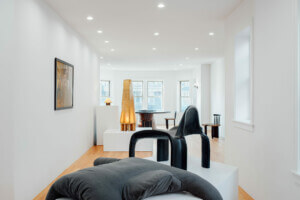Les lignes géométriques ne rendent pas les gens aimables. (Geometrical lines do not make people likable.) —Jacques Tati
It was 1958, a time of rapid economic growth in France and the United States. After the hardships of two world wars, a newfound prosperity reigned. It was the period of the International Style, an aesthetic driven by standardization and function, devoid of ornamentation and historical references.
The French filmmaker and actor Jacques Tati answered the era with the fifth film that he directed, a striking critique of modern architecture and design: Mon Oncle. The entirety of the film takes place at Villa Arpel, a Villa Savoye–esque boxy house filled with plastic furniture and high-tech appliances, where the protagonist, Monsieur Hulot, visits his nine-year-old nephew, Gérard Arpel. In a series of ongoing gags, the beloved uncle (played by Tati) is confronted by Gérard’s parents’ conspicuous displays of materialism.
The story unfolds in various scenes where comical interactions reveal the nonsensical quirks of modern life. In one scene, M. Hulot comes into contact with a bizarre grouping of Acapulco chairs. Somehow, everyone else manages to find a comfortable spot without fuss, but when the protagonist tries to sit, it appears as if he has fallen into a bucket and cannot get out. As others adjust themselves, M. Hulot attempts to rest as he would in a more traditional chair. The bit captures Tati’s suggestion that contemporary furniture like the chair is merely a stylistic representation of function—a design that is a statement about utility as opposed to an object that actually works. In the film, only M. Hulot seems to notice the chair’s truth.
Celebrating the filmmaker’s satire, New York gallery Les Ateliers Courbet joined forces with architecture studio Thirlwall Design to make a mock-up of the Villa Arpel, while French design firm Domeau & Pérès took to the director’s archives to re-create some of the set’s props. The resulting show, Please Be Seated, features three chairs that were inspired by originals Tati had designed for Mon Oncle. On view for the first time in New York, the limited-edition trio comprises a sofa with little or no seating space, a daybed with a precarious railing, and a rocking chair that easily tips over. These seats channel Tati to suggest the superficial pleasures of modern design.
Read the full story on our interiors and design website, aninteriormag.com.











